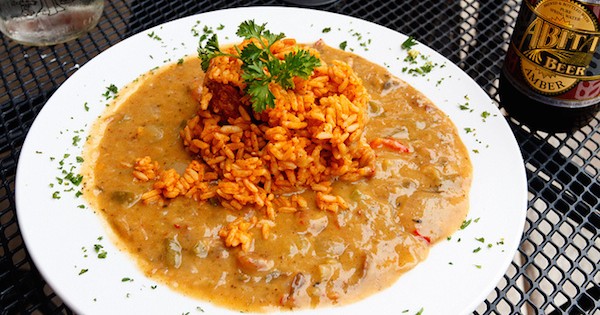
Red’s Chinese opened last summer on St. Claude Avenue in the Bywater neighborhood. The website features a pug wearing campy Asian headgear—a Red Army officer’s cap, a conical coolie hat. The menu borders on parody, as if from a Chinese restaurant that overstayed a vacation in the Deep South: General Lee’s chicken, crawfish rangoon, bok choy with smoked ham shank. Ribs are served with ironic slices of pouffy Bunny Bread, a regional brand that’s a close cousin to Wonder Bread. A Yelp reviewer wrote that “It’s the kinda place Anthony Bourdain will inevitably visit.” It’s unclear if this was a compliment or a complaint.
Red’s came up when I was talking with David Berriss for last week’s post about barbecue. He teaches anthropology at the University of New Orleans and mentioned that his students were grappling over how to define local. Is food considered local only if it includes locally grown or raised ingredients? Or can it be local even if the onions and celery from the back of a Sysco truck are deployed when making a classic jambalaya? The only agreement seemed to be that Red’s didn’t qualify in any way. “It’s self-consciously imitating Brooklyn,” Berriss said. “There’s nothing New Orleans about it.”
I’d wager that New Orleans has a larger stake when debating how to define local food than most other cities. It’s always prided itself on offering restaurant fare that you can’t find elsewhere. Tourism is the leading industry—last year the city drew 9.5 million people who spent $6.8 billion—and that industry is built in large part on people winging their way here to enjoy a distinctive cuisine.
But now New Orleans appears to be developing a culinary palate that mirrors many other cities—restaurants that opened in the past few years embrace what might be called hipster globalism. Booty’s Street Food offers a bazaar of dishes from around the world, all without the inconvenience of a passport. Johnny Sanchez brings trendy tacos to the Central Business District (“It’s a Mexican food revolution out there,” the local edition of the food website Eater reported). MoPho takes a cheeky, inventive approach to Asian fare. In Eater’s April list of 15 hot New Orleans restaurants, most feature imported cuisines—kebabs, falafel, updated Polynesian, Chinese, Israeli, fusion-esque (“Modern American meets Vietnamese, French, and Italian influence”).
So what’s happening to the city’s traditional fare? In part, it’s moved into gated communities that cater to the wealthy. You can still find the culinary classics at pricey French Quarter mainstays like Arnaud’s, Antoine’s, and Galatoire’s, which among them have been serving for 362 years. (Pete Wells of The New York Times recently noted that “the French Quarter has become something of a Jurassic Park for Creole cuisine.”)
Yet New Orleans tradition still inspires chefs opening new places, who use it for a launch pad. Another half-dozen entries on Eater’s April hot list riff on local or regional fare. That includes the newly revamped Brennan’s, Purloo, Brown Butter (Eater: “comfort food from the bible belt and around the south”), Balise, Angeline (southern with a Mediterranean influence), and Sac-a-lait (“all things Louisiana game and seafood”). Still, all of these restaurants, which opened in the past year, tend to skew pricey, and can be seen as part of the gentrification of southern dining.
Some of this may alarm local food protectionists, who don’t like to see old school New Orleans fare retreating to a castle in the face of barbarian hordes. Meantime, outside the walls, New Orleans starts to look like everywhere else.
But when you take the long view, that alarm may be misplaced. After all, much of the city’s most beloved fare today resulted from an invasion followed by hybridization. New Orleans loves to talk about food, and after considerable argument, many newcomer dishes are eventually given a seat at the table. Restaurants that serve “red gravy,” like Pascal Manale’s and Mandina’s, are artifacts of a Sicilian influx in the latter half of the 19th century. What’s today considered classic Cajun (itself imported from western Louisiana) emerged when African fare favored by slaves met Acadian French. Even the city’s vaunted Creole dishes emerged out of a cultural meeting ground once populated by French, Spanish, Caribbean islanders, Africans and their descendants, and Native Americans.
The latest incursion isn’t coming from a specific country or culture, of course. It’s from a globalized cuisine favored by a free-range clientele that was raised by the Food Network and Saveur and one-click international jet flights. Their world isn’t so much their oyster as an endless buffet table.
Still, I’m pretty confident New Orleans will eventually absorb this wave as well. Even Red’s Chinese is a laboratory for concocting the next new local, however that ends up being defined. The chef has said his menu draws in part from the old Times-Picayune cookbook. The kung pao pastrami—a dish gleefully expropriated and adapted from Mission Chinese in New York, where the chef once worked—is here reimagined with pepper, onions, and celery, the “holy trinity” that serves as bedrock for red beans and gumbo and many other revered local dishes.
Keeping local cuisine alive is a messy process. Perhaps it’s best to just stay out of the kitchen and enjoy what’s on your plate.

